1997 BUICK CENTURY window
[x] Cancel search: windowPage 155 of 406

Ventilation Tips
0 Keep the hood and front air inlet free of ice, snow or
any other obstruction, such
as leaves. The heater and
defroster will work far better, reducing the chance of
fogging the inside
of your windows.
When you enter a vehicle in cold weather, adjust the
mode knob or button to FLOOR and the fan to the
highest speed for a few seconds before driving off.
This helps clear the intake ducts
of snow and
moisture and reduces the chance
of fogging the
inside
of your windows.
Rear Window Defogger
C
D
REAR
0
0 Keep the air path under the front seats clear of
objects. This helps air to circulate throughout
your vehicle. The
rear window defogger uses a warming grid to
remove fog from the rear window. Press the button to
turn the rear defogger on.
It will turn itself off after
about
10 minutes.
3-11
ProCarManuals.com
Page 156 of 406
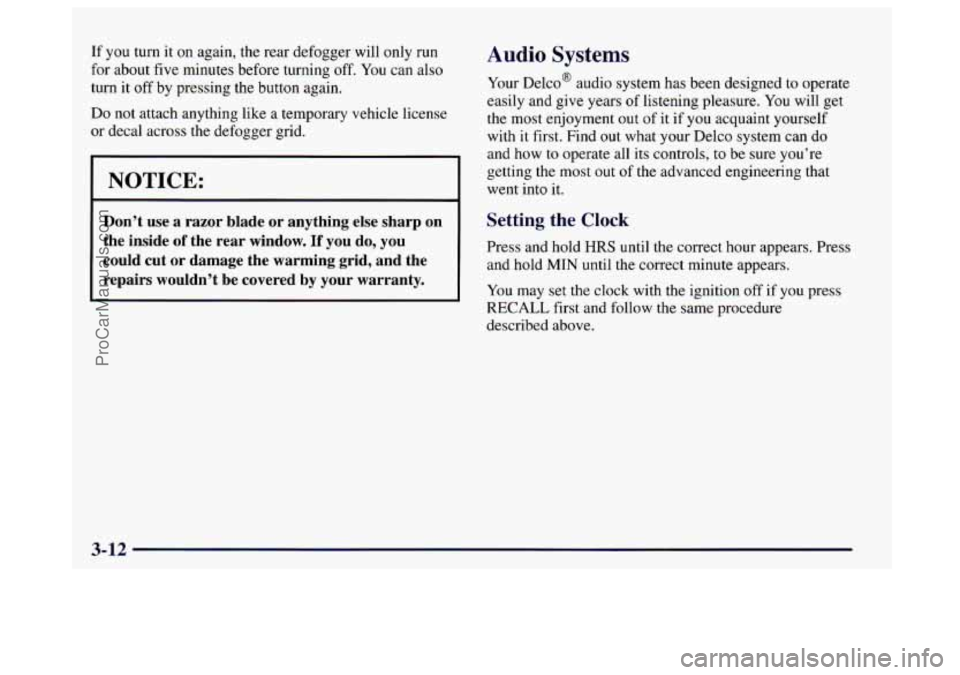
If you turn it on again, the rear defogger will only run Audio Systems
for about five minutes before turning off. You can also
turn it
off by pressing the button again. Your Delco@ audio system has been designed to operate
Do not attach anything like a temporary vehicle license
the most enjoyment out of it if you acquaint yourself
or decal across the defogger grid.
with it first. Find out what your Delco system can do
easily and give years
of listening pleasure.
You will get
h I and how to operate all its controls, to be sure you’re
I NOTICE: I
getting the most out of the advanced engineering that
went into
it.
I Don’t use a razor blade or anything else sharp on Setting the Clock
the inside of the rear window. If you do, you
could cut
or damage the warming grid, and the
repairs wouldn’t be covered by your warranty. and hold MIN until the correct minute appears.
Press and hold
HRS until
the correct hour appears. Press
You may
set the clock with the ignition off if you press
RECALL first and follow the same procedure
described above.
3-12
ProCarManuals.com
Page 181 of 406
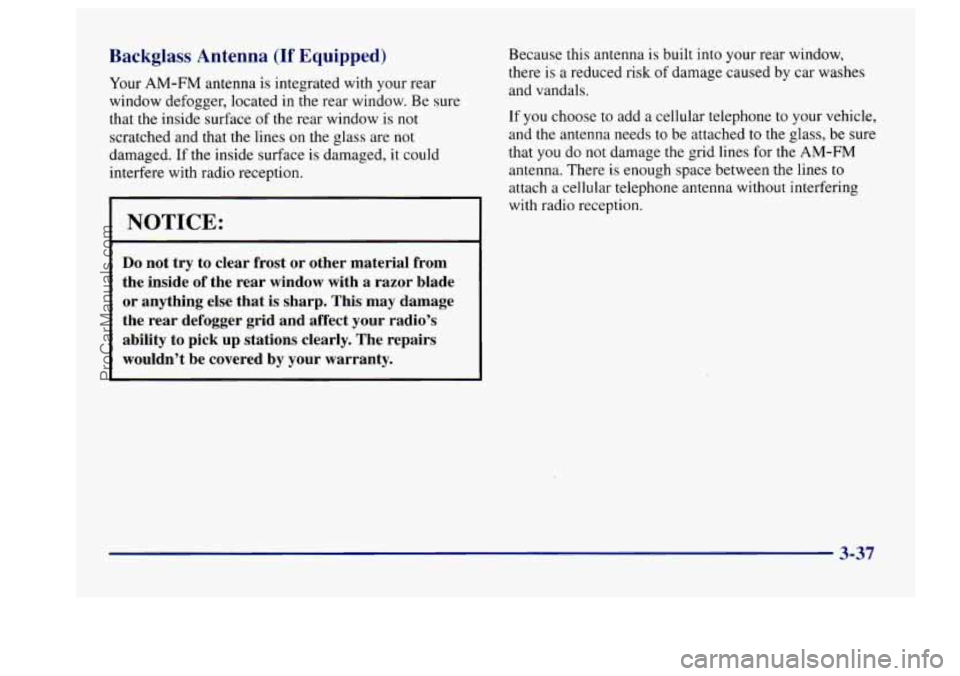
Backglass Antenna (If Equipped)
Your AM-FM antenna is integrated with your rear
window defogger, located in the rear window. Be sure
that the inside surface of the rear window is not
scratched and that the lines on the glass are not
damaged.
If the inside surface is damaged, it could
interfere with radio reception.
NOTICE:
Do not try to clear frost or other material from
the inside of the rear window with a razor blade
or anything else that
is sharp. This may damage
the rear defogger grid and affect your radio’s
ability to pick up stations clearly. The repairs
wouldn’t be covered by your warranty.
Because this antenna is built into your rear window,
there is a reduced risk
of damage caused by car washes
and vandals.
If you choose to add a cellular telephone to your vehicle,
and the antenna needs to be attached to the glass, be sure
that you do not damage the grid lines for the
AM-FM
antenna. There is enough space between the lines to
attach a cellular telephone antenna without interfering
with radio reception.
3-37
ProCarManuals.com
Page 207 of 406
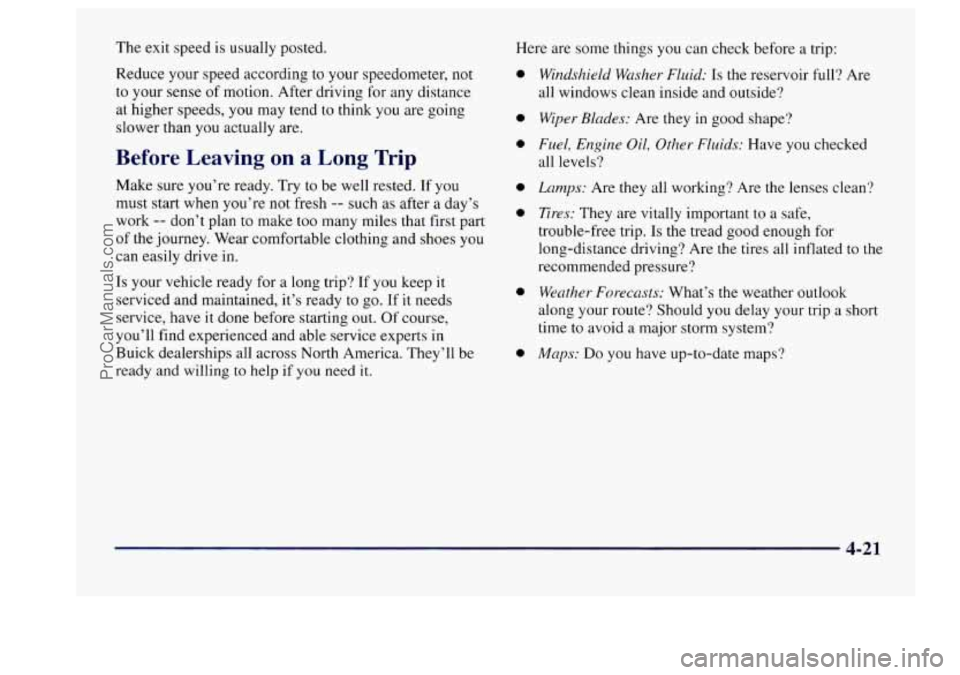
The exit speed is usually posted.
Reduce your speed according to your speedometer,
not
to your sense of motion. After driving for any distance
at higher speeds,
you may tend to think you are going
slower than you actually are.
Before Leaving on a Long Trip
Make sure you’re ready. Try to be well rested. If you
must start when you’re not fresh
-- such as after a day’s
work
-- don’t plan to make too many miles that first part
of the journey. Wear comfortable clothing and shoes you
can easily drive in.
Is your vehicle ready for a long trip? If you keep it
serviced and maintained, it’s ready to go. If it needs
service, have it done before starting out. Of course,
you’ll find experienced and able service experts in
Buick dealerships all across North America. They’ll be
ready and willing
to help if you need it. Here are some things
you can check before a trip:
0
0
0
0
0
0
0
Windshield Washer Fluid: Is the reservoir full? Are
all windows clean inside and outside?
Wiper Blades: Are they in good shape?
Fuel, Engine Oil, Other Fluids: Have you checked
all levels?
Lamps: Are they all working? Are the lenses clean?
Tires: They are vitally important to a safe,
trouble-free trip.
Is the tread good enough for
long-distance driving? Are the tires all inflated to the
recommended pressure?
Welzther Forecasts: What’s the weather outlook
along your route? Should you delay your trip a short
time
to avoid a major storm system?
Maps: Do you have up-to-date maps?
4-21
ProCarManuals.com
Page 213 of 406
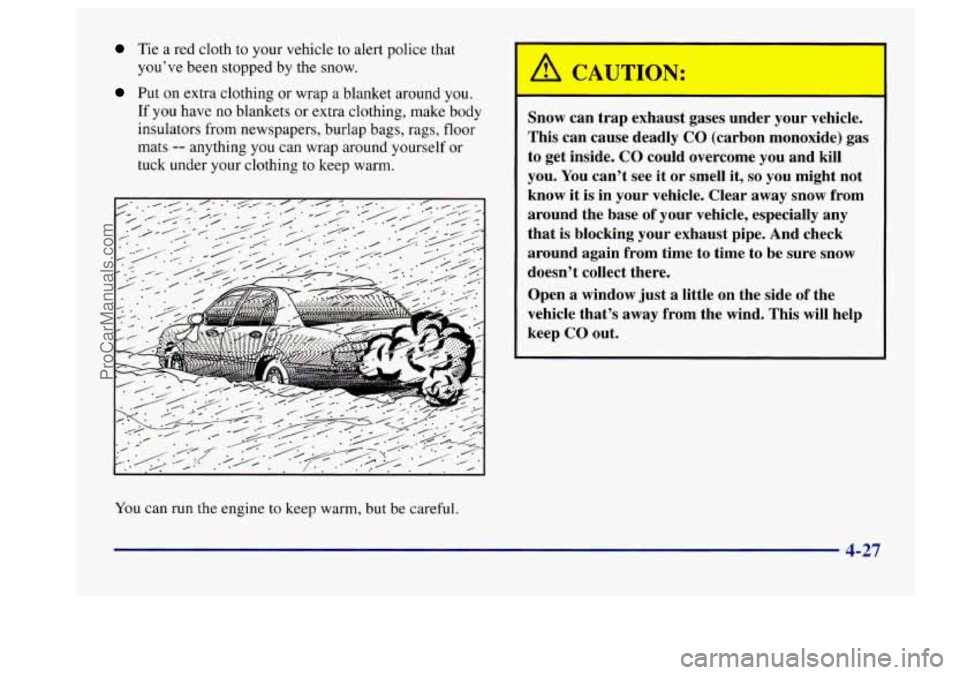
Tie a red cloth to your vehicle to alert police that
you’ve been stopped by the snow.
Put on extra clothing or wrap a blanket around you.
If you have no blankets or extra clothing, make body
insulators from newspapers, burlap bags, rags, floor
mats
-- anything you can wrap around yourself or
tuck under your clothing
to keep warm.
’ A CA”T1CY:
Snow can trap exhaust gases under your vehicle.
This can cause deadly
CO (carbon monoxide) gas
to get inside. CO could overcome you and kill
you. You can’t see it or smell it,
so you might not
know it is in your vehicle. Clear away snow from
around the base of your vehicle, especially any
that
is blocking your exhaust pipe. And check
around again from time to time to be sure snow
doesn’t collect there.
Open a window just a little on the side of the
vehicle that’s away from the wind. This will help
keep CO out.
You can run the engine to keep warm, but be careful.
4-27
ProCarManuals.com
Page 214 of 406

Run your engine only as long as you must. This saves
fuel. When you run the engine, make it go a little faster
than just idle. That is, push the accelerator slightly. This
uses less
fuel for the heat that you get and it keeps the
battery charged. You will need a well-charged battery to
restart the vehicle, and possibly for signaling later
on
with your headlamps. Let the heater run for a while.
Then, shut the engine
off and close the window almost
all
the way to preserve the heat. Start the engine again
and repeat this only when you feel really uncomfortable
from the cold. But
do it as little as possible. Preserve the
fuel as long as you can.
To help keep warm, you can get
out
of the vehicle and do some fairly vigorous exercises
every half hour or
so until help comes.
Loading Your Vehicle
TIRE-LOADING INFORMATION
VEHICLE CAP. WT.
FRT. CTR.
RR. TOTAL LBS.
MAX. LOADING & GVWR SAME AS VEHICLE
CAPACITY WEIGHT
XXX COLD TIRE
TIRE
SIZE SPEED PRESSURE RTG PSI/KPa
FRT.
RR.
SPA. IF TIRES ARE
HOT, ADD 4PSIi28KPa
SEE OWNER'S MANUAL
FOR ADDITIONAL
INFORMATION
Two labels on your vehicle show how much weight it
may properly carry. The Tire-Loading Information label
is inside the trunk lid. The label tells you the proper size,
speed rating and recommended inflation pressures for
the tires
on your vehicle. It also gives you important
information about the number of people that can
be in
your vehicle and the total weight you can carry. This
weight
is called the vehicle capacity weight and includes
the weight of all occupants, cargo and all
nonfactory-installed options.
4-28
ProCarManuals.com
Page 242 of 406
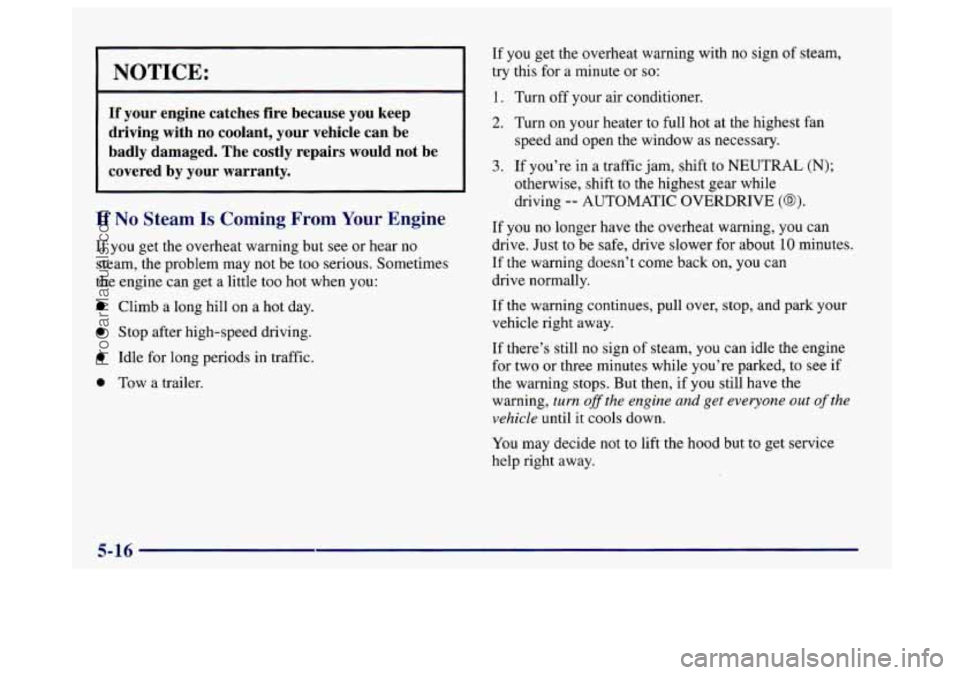
NOTICE:
If you get the overheat warning with no sign of steam,
try this for a minute or so:
1. Turn off your air conditioner.
If your engine catches fire because you keep
driving with no coolant, your vehicle can be
badly damaged. The costly repairs would not be
covered by your warranty.
3. If you’re in a traffic jam, shift to NEUTRAL (N);
2. Turn on your heater to full hot at the highest fan
speed and open the window as necessary.
otherwise, shift to the highest gear while
driving
-- AUTOMATIC OVERDRIVE (a).
If No Steam Is Coming From Your Engine
If you get the overheat warning but see or hear no
steam, the problem may not be too serious. Sometimes
the engine can get a little too hot when you:
Climb a long hill on a hot day.
0 Stop after high-speed driving.
0 Idle for long periods in traffic.
0 Tow a trailer. If you
no longer have the overheat warning, you can
drive. Just
to be safe, drive slower for about 10 minutes.
If the warning doesn’t come back on, you can
drive normally.
If
the warning continues, pull over, stop, and park your
vehicle right away.
If there’s still no sign
of steam, you can idle the engine
for two or three minutes while you’re parked,
to see if
the warning stops. But then, if you still have the
warning,
turn ofthe engine and get everyone out of the
vehicle
until it cools down.
You may decide not to lift the hood but
to get service
help right away.
5-16
ProCarManuals.com
Page 311 of 406
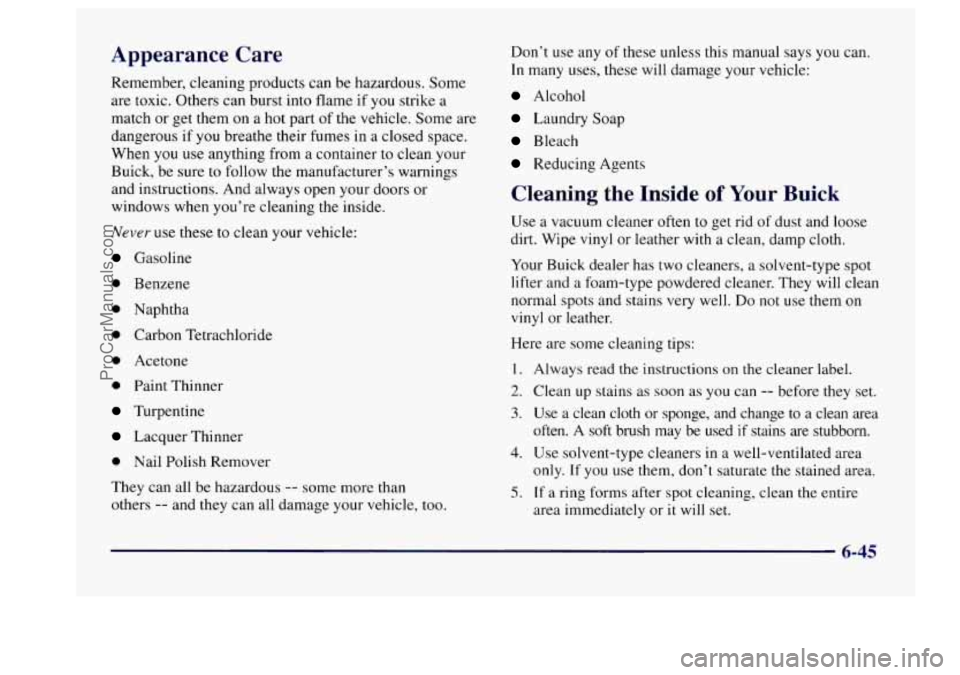
Appearance Care
Remember, cleaning products can be hazardous. Some
are toxic. Others can burst into flame if
you strike a
match or get them on a hot part of the vehicle. Some are
dangerous if
you breathe their fumes in a closed space.
When you use anything from a container to clean your
Buick, be sure to follow the manufacturer’s warnings
and instructions. And always open your doors or
windows when you’re cleaning the inside.
Never use these to clean your vehicle:
Gasoline
0 Benzene
0 Naphtha
0 Carbon Tetrachloride
0 Acetone
0 Paint Thinner
Turpentine
Lacquer Thinner
0 Nail Polish Remover
They can all be hazardous
-- some more than
others
-- and they can all damage your vehicle, too. Don’t
use any of these unless this manual says you can.
In many uses, these will damage your vehicle:
Alcohol
Laundry Soap
Bleach
Reducing Agents
Cleaning the Inside of Your Buick
Use a vacuum cleaner often to get rid of dust and loose
dirt. Wipe
vinyl or leather with a clean, damp cloth.
Your Buick dealer has two cleaners,
a solvent-type spot
lifter and
a foam-type powdered cleaner. They will clean
normal spots and stains very well.
Do not use them on
vinyl or leather.
Here are some cleaning tips:
1.
2.
3.
4.
5.
Always read the instructions on the cleaner label.
Clean up stains as soon as you can -- before they set.
Use
a clean cloth or sponge, and change to a clean area
often. A soft brush may be used
if stains are stubborn.
Use solvent-type cleaners in
a well-ventilated area
only.
If you use them, don’t saturate the stained area.
If a ring forms after spot cleaning, clean the entire
area immediately or
it will set.
6-45
ProCarManuals.com